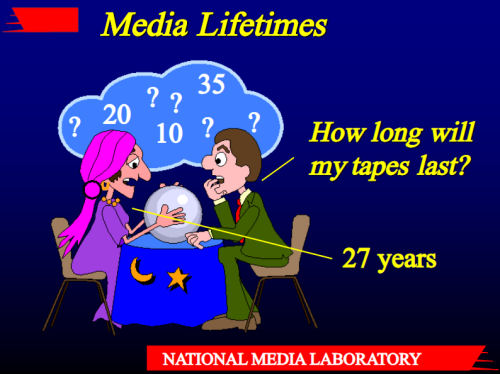Life Expectancy: How Long Will Taped Programming Last?
Material on this page is drawn from The Council on Library and Information Resources: http://www.clir.org/pubs/reports/pub54/4life_expectancy.html, 12/24/2013. Content used with permission. CLIR is an independent, nonprofit organization that forges strategies to enhance research, teaching, and learning environments in collaboration with libraries, cultural institutions, and communities of higher learning.

An amusing, but dire view: PowerPoint slide #7 from a presentation on Storage Media Life Expectancies from John Van Bogart at a National Media Laboratory Digital Archive Directions Workshop, June 22, 1998.
A Guide for Libraries and Archives
Dr. John W.C. Van Bogart
National Media Laboratory, June 1995
Unfortunately, media life expectancy information is largely undocumented, and a standard method for determining magnetic media lifetimes has yet to be established. The need for this information fuels the ongoing NML media stability studies, which have incorporated accelerated temperature/humidity and corrosion environments to measure performance over time and to develop models to forecast extended media lifetimes. A simple example as to how Life expectancies can be determined is provided in the Appendix under Estimation of Magnetic Tape Life Expectancies.
According to manufacturers’ data sheets and other technical literature, thirty years appears to be the upper limit for magnetic tape products, including video and audio tapes. Life expectancy values for storage media, however, are similar to miles per gallon ratings for automobiles. Your actual mileage may vary.
Recently, articles have been appearing which suggest that the life expectancy of magnetic media is much shorter than originally thought. For example, an article in the January 1995 Scientific American ( Jeff Rothenberg, “Ensuring the Longevity of Digital Documents”) conservatively estimated the physical lifetime of digital magnetic recording tape at one year. Because of the confusion that can result from such a statement, NML officially responded with a letter to the editor that appeared in the June 1995 issue of Scientific American. The letter states that the “physical lifetimes for digital magnetic tape are at least 10 to 20 years.”

Media Life Expectancy: 10-30 years for magnetic tape. This graphic is from “Digital Media Life Expectancy and Care” by Michael W. Gilbert, Special Projects, UMass Amherst.
Practical Life Expectancies
Those accustomed to storing paper and microfilm may be annoyed by the relatively short life expectancies (ten to thirty years) of magnetic tape materials. Some gold plated/glass substrate digital optical disc technologies promise 100-year lifetimes. However, a 100-year life expectancy is irrelevant when the system technology may be in use for no more than ten or twenty years (or less).
Audio and video recording technologies are advancing at a much faster rate than printing and microfilming technologies. We are fortunate if a recording technology stays current for more than twenty years. In the case of a magnetic recording media with a fifty-year life expectancy, the media would undoubtedly outlive the recording system technology. To truly achieve a fifty-year archival life, recording systems, sufficient spare parts, and technical manuals would need to be archived along with the recorded media.
In the case of audio and video archives, transcription is inevitable. Rather than trying to preserve old, outdated recording formats and technologies, it may be more practical to transcribe on a regular basis – every ten to twenty years or even more frequently. The old copy could be preserved until the new copy is transcribed to the next generation of recording system. In this fashion, at least two copies of the material are always in existence.
